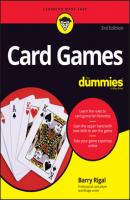Card Games For Dummies. Barry Rigal
Чтение книги онлайн.

Читать онлайн книгу Card Games For Dummies - Barry Rigal страница 13
Название: Card Games For Dummies
Автор: Barry Rigal
Издательство: John Wiley & Sons Limited
Жанр: Сделай Сам
isbn: 9781119880448
isbn:
If you’re picking the game based on time constraints:
You can play Setback (Chapter 15), Whist (Chapter 8), and Euchre (Chapter 10) to specified target scores, which you can adapt to reflect the time you have available.
You can play Ninety-Nine (Chapter 9) for a specified number of hands.
If you have a few years at your disposal, I recommend an ongoing battle of Spite and Malice (Chapter 2).
If you’re selecting your game based on the type of play:
Serious, competitive types tend to enjoy Whist (Chapter 8) and Bridge (Chapter 12).
If you’re playing in a cramped space (on a plane, train, or bus), Hearts (Chapter 13) and Eights (Chapter 6) work well.
In a bar, Cribbage (Chapter 16) goes well with alcohol.
For large groups in a social setting, Poker (Part 6) and Blackjack (Chapter 18) are ideal.
For games that combine bidding and play, Pinochle (Chapter 14) and Spades (Chapter 11) are good choices.
The best partnership games are Bridge (Chapter 12), Whist (Chapter 8), and Euchre (Chapter 10).
If your deck of cards is defective, you want to play a game that doesn’t deal out all the cards. You can play Oh Hell! (Chapter 9), Spite and Malice (Chapter 2), and Setback (Chapter 15) with a deck that has missing cards.
If you’re selecting the game based on the experience level of the players:
For beginners: Oh Hell! and Ninety-Nine (both in Chapter 9) have simple, easy-to-understand principles.
For children: Go Fish and Cheat (both in Chapter 3) are simple, but they require younger players to think in order to win. Whist (Chapter 8) is the best introduction to trick-taking games for children.
For groups with mixed experience levels: Whist (Chapter 8) and Fan Tan (Chapter 7) rely heavily on luck, which gives everyone a sporting chance. Rummy (Chapter 4) also comes easily to inexperienced card players.
For experienced card players: Pinochle (Chapter 14) and Cribbage (Chapter 16) offer new thrills and challenges.
Chapter 2
Solitaire
IN THIS CHAPTER
You see many different versions of Solitaire in this chapter. The different games don’t have all that much in common, except that you can play them with a single deck of cards (and they happen to be my favorite Solitaires). Some Solitaires need more than one deck, but not the ones included in this chapter (apart from the two-player, Solitaire-like game Spite and Malice at the end of the chapter). These games range from automatic Solitaires, where you can make every move immediately without thought or forethought, to Solitaires where you can plan your game strategy for at least 10 minutes if you want to. These games aren’t easy, so if you win any of them, you’ll feel a sense of achievement. In fact, I have never managed to win some of the Solitaires that I discuss in this chapter.
One player
One standard 52-card deck of cards (you usually don’t need jokers in games of Solitaire)
Space to spread out the cards
Acquainting Yourself with Solitaire Terms
Before you start enjoying the various games of Solitaire, you need to know a little technical vocabulary:
When you initially deal the cards, the pattern is known as a layout or tableau. The layout can consist of rows (horizontal lines of cards), columns (vertical lines), or piles of cards (a compact heap, frequently of face-down cards, sometimes with the top card face-up). Sometimes the pile of cards is all face-up, but overlapping. Accordingly, you can see all the cards in the pile, even if you can only access the top, uncovered card. You can move tableaus under the correct circumstances, which are dictated by the rules of the particular Solitaire you’re playing.
Building involves placing one card on top of another in a legal move. The definition of a legal move varies according to the individual rules of the Solitaire.
In games where the objective СКАЧАТЬ